Anyone who’s ever attended a hacker conference knows that the talks and workshops are only part of the reason that people travel from all over the country (and indeed, the world) to be there. The social and extracurricular aspects of these events are just as important as the scheduled content, if not more so. After all, you can always watch the recorded version of any presentation you missed when you get back home; but there’s only a relatively short window for drinking Club-Mate, driving a Segway at unreasonable speeds, and hanging out with other people in the community.
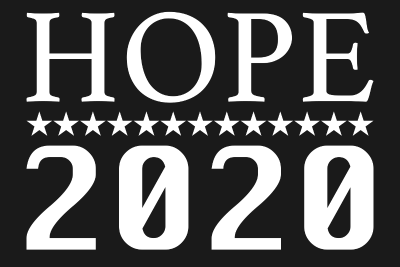 So I don’t mind admitting that I was extremely skeptical when it was announced that the Hackers On Planet Earth (HOPE) conference was going virtual due to the COVID-19 pandemic. Especially since the decision came just a few months before the event was set to kick off in New York. Trying to recreate the experience of a large scale hacker con as an online-only event is hard enough, but doing it on such short notice seemed like a recipe for disaster. Particularly for an event like HOPE that had always crammed the historic Hotel Pennsylvania to the rafters (and sometimes, above) with content and activities.
So I don’t mind admitting that I was extremely skeptical when it was announced that the Hackers On Planet Earth (HOPE) conference was going virtual due to the COVID-19 pandemic. Especially since the decision came just a few months before the event was set to kick off in New York. Trying to recreate the experience of a large scale hacker con as an online-only event is hard enough, but doing it on such short notice seemed like a recipe for disaster. Particularly for an event like HOPE that had always crammed the historic Hotel Pennsylvania to the rafters (and sometimes, above) with content and activities.
Which is not to say they didn’t have some interesting ideas. Since so many people were stuck at home anyway, they decided there wasn’t much point limiting HOPE to a single weekend. For 2020, the event would instead run for nine continuous days. Prerecorded talks and interactive workshops would start at 9 AM Eastern and run right up until the wee hours of the morning, often concluding with a live musical performance.
As founder Emmanuel Goldstein described it, the idea was to turn this year’s HOPE into a 24 hour hacker television channel that could beam a diverse array of ideas and opinions into homes all over the planet. Rather than pretending that the classic hacker convention experience could be fully replicated online, they would fully embrace the possibilities offered by the Internet and create something completely different. But could they pull it off?
A Place to Call Home
Whether it runs for two days or nine, an online event needs a central place where attendees can communicate, and these days there’s no shortage of chat platforms to chose from. But the types of people who read 2600 and attend HOPE have some pretty strong opinions on software, so deciding what technology the event would use to bring everyone together was tricky.
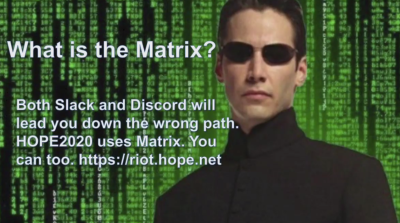
The Graybeards would have been happy to stick to IRC, where 2600 has maintained a tight-knit community for decades. While the newer players would naturally prefer something they’re more familiar with, such as Slack or Discord. Unfortunately, the privacy issues inherent with proprietary communications platforms are in direct opposition to everything 2600 and HOPE stands for. So in the end they compromised by using Matrix, an open source decentralized chat protocol that supports modern mobile and web clients such as Element.
A self-hosted Matrix server was spun up specifically for HOPE, with the “ticket” code attendees received serving as a token to log into the array of channels that had been set up. A bit of guerrilla marketing was used to get as many people on the server as possible, with images popping up between talks explaining why Matrix was a better choice for the hacker community. The number of active users varied from day to day, but by the closing ceremonies, the server boasted slightly north of 1,600 user accounts.
The Matrix server started out with dedicated channels to discuss the streaming presentations as well as the interactive workshops, but it also had channels where users could chat about current events or request technical assistance. As the days went on, the users started to create new channels and the server experienced a sort of organic growth. Soon there was a place to show off your personal projects, find a new job, or just talk with people from your geographical corner of the globe.
Overwhelming Demand
Whether organizers were concerned about the technical ramifications of having too many users logged into each workshop, or they just wanted to limit the logistical issues for the presenters, it had been decided early on that the interactive classes would all have hard limits on how many could attend. If you wanted to participate in a workshop, you needed to register ahead of time to reserve a spot. The most popular ones filled up almost immediately, and within just a few hours, nearly every workshop scheduled for the entire nine day conference was showing that they were no longer available.
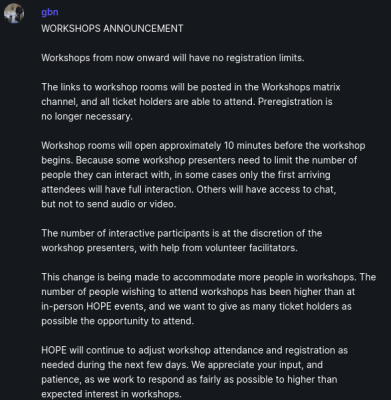
This was a fairly serious problem. All of the talks at HOPE were streamed online for free, so the only advantage to purchasing a $200 ticket this year was that it granted you access to the Matrix server and the workshops. With all of the workshops seemingly off the table, attendees started voicing their displeasure in the chat.
Some felt that they’d been mislead, and that it should have been made clear when they purchased their tickets that space would be limited in the workshops. It’s understandable that a room can fill up to capacity at a traditional hacker convention; but when it’s online and free from physical constraints, nobody expected they’d be fighting for seats.
But just as things reached a fever pitch in the chat, cooler heads prevailed. The event organizers pulled down the registration pages and made the backend changes necessary to allow an unlimited number of viewers into each class. There were still some limitations, as only the first 30 or so people would have the ability to use their microphone to directly speak with the presenter, but most people were happy just to passively watch and use the text chat. Additional volunteer moderators would also be assigned to help deal with the higher than expected number of participants in each class so as not to disrupt the experience for anyone else.
As Open As Possible
Between Matrix for chat and BigBlueButton for workshops, it was clear that HOPE was leaning heavily on open source software. Organizers not only wanted to keep as much of the operations in-house as possible, but they wanted to make sure nobody was prevented from joining in the festivities because they lacked the proper license or operating system. For an organization like 2600, you’d expect no less.
But more than that, the event itself attended an impressive level of openness. There was a high level of transparency for an operation of this scale, and a two hour “How We Did It” roundtable discussion during the closing ceremonies walked viewers through the various software tools they used and even provided details on the hardware everything was served off of. With so many events going digital, the organizers wanted HOPE to serve as a case study for other groups who might have to move their operations into the digital realm. Whether you wanted to know how to provide a dynamic schedule to your attendees or how to mitigate distributed denial-of-service attacks against your Matrix server, the information was there for the taking.
An Event Like No Other
In extending the length of HOPE and providing such a rich virtual environment for attendees to congregate, the event really took on a life of its own. This was perhaps best exemplified by the “bumps” that played between talks. Viewers were invited to submit short videos that would be randomly inserted into the stream whenever there was a lull in programming. As the days went on these videos became increasingly elaborate, eventually encompassing surreal mock commercials and short films broken up into small chunks. It’s something that simply couldn’t have happened at a physical event, or even a shorter online one for that matter.
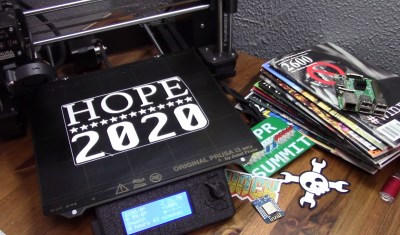
The decision to make most talks pre-recorded also ended up working out very well. This served to greatly improve the production value on the talks, as you were watching the presenter’s edited best cut versus a live presentation that could be plagued by technical issues.
You didn’t have to worry about the demo not working, the presenter’s laptop battery cutting out, or the perennially missing HDMI cable; everything was smooth and professional. It also gave presenters the unique opportunity to chat with the viewers and answer questions in real-time as the video played, which in a way actually made for a more personal experience than what’s possible at a physical con.
Was this nine day hacker TV station a direct replacement for an in-person event? No. But that was never the goal. It was something completely different, and in some ways managed to clearly improve on the traditional formula. As the HOPE conference has always been biennial, it would be interesting to see this virtual version revived on the off years as a way to raise funds for 2600. It would certainly be a shame if we had to wait for the next global pandemic before we got to see another event of this scale.

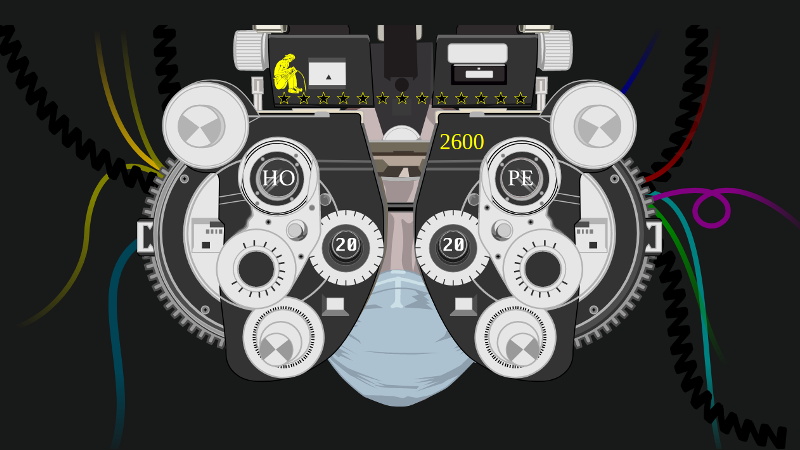














Hi Survivors of HOPE 2020,
Which software setup do you recommend to visitors of upcoming Matrix based events?
https://hope.net/faq.html seems unaware of the 2020 online edition.